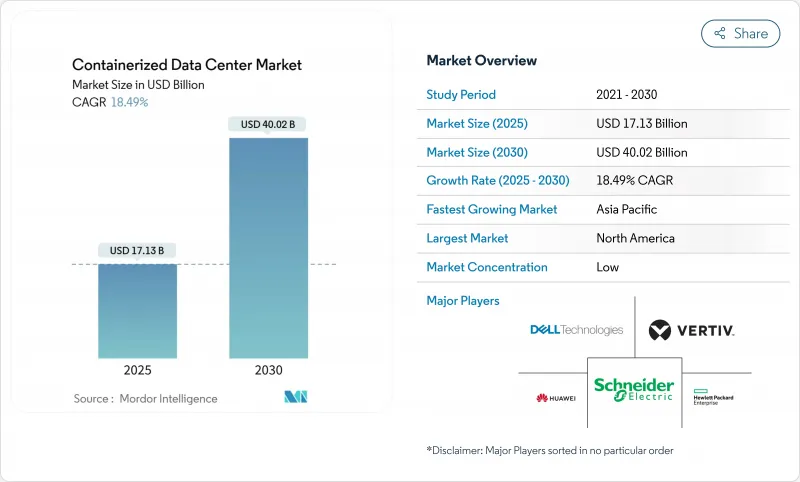
|
市場調査レポート
商品コード
1851273
コンテナ型データセンター:市場シェア分析、産業動向、統計、成長予測(2025年~2030年)Containerized Data Center - Market Share Analysis, Industry Trends & Statistics, Growth Forecasts (2025 - 2030) |
||||||
カスタマイズ可能
適宜更新あり
|
|||||||
| コンテナ型データセンター:市場シェア分析、産業動向、統計、成長予測(2025年~2030年) |
|
出版日: 2025年07月03日
発行: Mordor Intelligence
ページ情報: 英文 120 Pages
納期: 2~3営業日
|
概要
コンテナ型データセンター市場は、2025年に171億3,000万米ドルに達し、2030年には400億2,000万米ドルに達すると予測され、CAGRは18.49%で推移します。

5Gの展開、エッジコンピューティング、より厳格な持続可能性の義務化によって、迅速な展開容量に対する需要が急増し、注文帳簿の長期化が続いています。ハイパースケール・オペレーターは、数年にわたる建設の遅れを埋めるためにコンテナ・モジュールを利用し、企業はデータ主権規則を満たすためにコンテナ・モジュールを導入します。プレハブの効率性は、電力使用効率(PUE)マージンを引き締め、総所有コストを下げ、モビリティを競争上の差別化要因にしています。ベンダーは、液体冷却、熱回収、原子力または水素マイクログリッドを組み合わせることで、余剰電力を回収し、コンテナ型データセンター市場を持続的な2桁拡大に向けて位置づけています。
世界のコンテナ型データセンター市場の動向と洞察
エッジ/5G構築でマイクロサイトが加速
通信キャリアは、超低遅延サービスをサポートするために、数千のマイクロエッジノードを展開しており、発注から「点灯」まで数週間で完了するモジュール式ユニットを選択しています。2024年5月のANSI/TIA-942-Cの更新により、タイプAとタイプBのマイクロエッジの格付けが作成され、事業者は統一されたコンプライアンスパスを得ることができ、調達サイクルを加速させることができます。コンテナ・フォーム・ファクターにより、プロバイダーはカバレッジ・マップの進化に合わせて容量を再配置することができ、密集した都市の中心部でも地方の隙間でもコンテナ型データセンター市場のプレゼンスが強化されます。需要は自律走行車、産業用IoT、AR/VRに及び、これらはすべてネットワーク・エッジで一貫した10ミリ秒以下のレイテンシを必要とします。ベンダーは現在、5G無線、MECサーバー、バッテリー・ストレージをシングル・リフト・ユニットにバンドルし、展開のタイムラインと資本リスクを圧縮しています。5Gの高密度化が2026年にピークを迎える中、民間ネットワーク・プロジェクトの第2波がマイクロサイトのパイプラインを活発化させると思われます。
ティア1ハブの容量不足
バージニア北部、シリコンバレー、ロンドンにおける土地、電力、許認可のボトルネックにより、新たなハイパースケールプロジェクトは2028年のコミッショニングウィンドウに追いやられ、事業者は8~12週間で本稼働できる暫定的なモジュラーキャパシティをリースすることを余儀なくされています。こうして、コンテナ型データセンター市場は、一時的なオーバーフローから戦略的なフットプリントへとシフトし、クラウド企業がグリッド制約にもかかわらず顧客のSLAを維持することを可能にしています。バージニア州の不動産投資家は、変電所のアップグレードの近くに位置するモジュラー・キャンパスの入居プレミアムが20%を超えたと報告しています。企業は、モジュールを権利の遅延や送電網の停止に対する保険と見なしており、常設ホールがオンラインになれば、多くの企業がユニットの再配置を計画しています。
限られたラック密度とハイパースケールのニーズ
ISOの40フィートボックスは通常、ラックあたり10~15kWをサポートし、1つのモジュールで60~180kWのIT電力を上限とするのに対し、専用のハイパースケール・スイートは20~40kWの密度を持ち、同等の床面積で300~500kWに達します。そのため、1ラックあたり数百のGPUを必要とするAIやHPCクラスタは、複数のコンテナや特殊な液体冷却の改修を必要とし、MWあたりの資本コストが膨らみます。東京やフランクフルトのような、1平方メートルごとに割高な不動産市場では、密度の差はさらに大きくなります。ベンダーは浸漬型コールドプレート設計でこれに応えているが、導入の実証ポイントはまだ限られています。密度が同等になるまで、一部のハイパースケールアーキテクトは、コンテナ型システムを周辺機器や過渡的な負荷用に確保すると思われます。
セグメント分析
2024年のコンテナ型データセンター市場シェアの78.2%は購入オプションが占め、BFSIや政府による資産管理の義務化がその要因となっています。しかし、リース/「White-Space-as-a-Service」はCAGR 20.1%で成長しています。早期導入企業は、バンドルされたモニタリングとリフレッシュ・サービスがスタッフの負担を軽減し、テクノロジーの陳腐化リスクを軽減することに注目しています。ヒューレット・パッカード・エンタープライズのFacility-as-a-Serviceは、複数年にわたるパフォーマンスSLAを保証しており、既存ベンダーがサブスクリプションの経済性を受け入れていることを示しています。
リースは中堅企業にとってハイスペックなキャパシティを民主化し、二次的なメトロやエッジの使用事例におけるコンテナ型データセンター市場のフットプリントを拡大します。新興企業は初期投資を回避でき、大企業は残存価値リスクを軽減できます。期間終了後にモジュールを返却、再配置、交換できる柔軟性も、変動の激しいAIのワークロードプロファイルに適しています。購入モデルは、セキュリティ分類やカスタムエンジニアリングがリースの利便性を上回る場合に存続すると思われます。
ISO 40フィートシェルは、2024年のコンテナ型データセンター市場規模の54.6%を占め、世界的な貨物規格とラック当たりのコスト削減の恩恵を受けています。CAGR19.7%で成長するカスタマイズ/オールインワンスキッドは、ラック数の増加、チップへの直接冷却、オンボードUPSを統合し、AIや分析クラスタにアピールします。UL 2755認証は固定設備と同等の安全性を保証し、企業の調達ハードルを緩和します。
特注のサーマル・エンベロープに対する需要により、ベンダーは30kW超のラックや熱再利用ループを非標準的なフットプリント内に設計するようになり、平均販売価格が上昇する一方で、グリーンフィールド・ホールと比較して導入期間が短縮されます。2026年以降、ラックの電力が増大する中、多くのハイパースケールアーキテクトは、再生可能エネルギー供給ポイントの近くにGPUを設置する唯一の現実的なルートとして、カスタムスキッドを考えています。ISO 20フィートボックスは、ニッチではあるが、テレコムエッジシェルターやスペースに制約のある都市部の屋上には依然として適しています。
コンテナ型データセンター市場は、所有タイプ(購入、リース/「White-Space-As-A-Service」)、コンテナタイプ(ISO 20-Ft、ISO 40-Ft、カスタマイズ/オールインワンスキッド)、展開場所(コア/キャンパス、エッジ/マイクロ、リモート/過酷環境)、エンドユーザー産業(IT・通信、BFSIなど)、地域別に区分されます。市場予測は金額(米ドル)で提供されます。
地域別分析
北米は2024年の売上高の29.3%を占め、テキサス州、ジョージア州、アルバータ州における暗号鉱山のAIキャンパスへのハイパースケール転換がその主因となっています。米国は、新しいグリッド相互接続のための数年待ちのバックログを回避するためにモジュールを吸収し、カナダはタールサンド監視と北極ブロードバンドゲートウェイに堅牢なポッドを採用しています。メキシコのニアショアリング・ルネッサンスにより、マキラドーラ工場のオーナーは、米国の物流ハブとリアルタイムの品質データを同期させるエッジポッドを導入しています。このような動向により、コンテナ型データセンター市場は大陸を横断する戦略的オーバーレイとして強化されます。
アジア太平洋はCAGR18.5%で最も急成長している地域であり、中国、インド、ASEANで5Gのマクロ構築とスマートシティの試験運用が拡大しています。各州はコンテナ・クラスターを前倒しで許可しています。インドのデータローカライゼーション・ルールブックは、クラウドプロバイダーが市民データを消費ゾーンの近くに囲い込むことを可能にし、マイクロリージョナル・ポッドの需要を押し上げます。日本とオーストラリアは、鉄骨モジュール特有の耐震性とサイクロン耐性を高く評価しています。これらの多様な要因が、この地域の受注パイプラインを強固なものにしています。
その他の特典:
- エクセル形式の市場予測(ME)シート
- 3ヶ月間のアナリストサポート
よくあるご質問
目次
第1章 イントロダクション
- 調査の前提条件と市場の定義
- 調査範囲
第2章 調査手法
第3章 エグゼクティブサマリー
第4章 市場情勢
- 市場概要
- 市場促進要因
- 携帯性と迅速な展開
- エッジ/5Gの構築がマイクロサイトを加速させる
- ティア1ハブのデータセンター容量不足
- エネルギー効率の高いプレハブがTCOを削減する
- SMRによるマイクログリッドがオフグリッドDCを可能にする
- 暗号からAIへのサイト変換が座礁電力を解き放つ
- 市場抑制要因
- 限られたラックとコンピュート密度vsハイパースケールニーズ
- レガシーDCとの統合の複雑さ
- ISOコンテナのサプライチェーンのボトルネック
- 液冷のレトロフィットがCAPEXを上昇させる
- サプライチェーン分析
- 規制情勢
- テクノロジーの展望
- ポーターのファイブフォース
- 供給企業の交渉力
- 買い手の交渉力
- 新規参入業者の脅威
- 代替品の脅威
- ライバルの激しさ
- 市場のマクロ経済要因の評価
第5章 市場規模と成長予測
- 所有形態別
- 購入
- リース/ ホワイトスペース・アズ・ア・サービス
- コンテナタイプ別
- ISO 20-ft
- ISO 40-ft
- カスタマイズ/オールインワン・スキッド
- 展開地域別
- コア/キャンパス
- エッジ/マイクロ
- 遠隔地/過酷な環境
- エンドユーザー業界別
- IT・通信
- BFSI
- 政府および防衛
- ヘルスケア
- 教育
- その他
- 地域別
- 北米
- 米国
- カナダ
- メキシコ
- 南米
- ブラジル
- アルゼンチン
- その他南米
- 欧州
- ドイツ
- 英国
- フランス
- オランダ
- その他欧州地域
- アジア太平洋地域
- 中国
- 日本
- インド
- 韓国
- オーストラリアおよびニュージーランド
- その他アジア太平洋地域
- 中東・アフリカ
- 中東
- アラブ首長国連邦
- サウジアラビア
- トルコ
- その他中東
- アフリカ
- 南アフリカ
- エジプト
- ナイジェリア
- その他アフリカ
- 北米
第6章 競合情勢
- 市場集中度
- 戦略的動向
- 市場シェア分析
- 企業プロファイル
- Vertiv
- Schneider Electric
- Huawei Technologies
- Dell Technologies
- Hewlett Packard Enterprise
- IBM Corporation
- Cisco Systems
- Rittal GmbH and Co. KG
- Delta Electronics
- Eaton Corporation
- Johnson Controls
- PCX Corporation
- BMarko Structures
- Baselayer Technology
- Flexenclosure(Xerxes)
- Cirrascale Cloud Services
- ZTE Corporation
- AST Modular(subs. of Schneider)
- Cannon Technologies
- EdgeMicro/EDJX
- Compass Datacenters
- EdgeConneX
- Vertiv(Emerson Network Power legacy)
- Stulz GmbH

